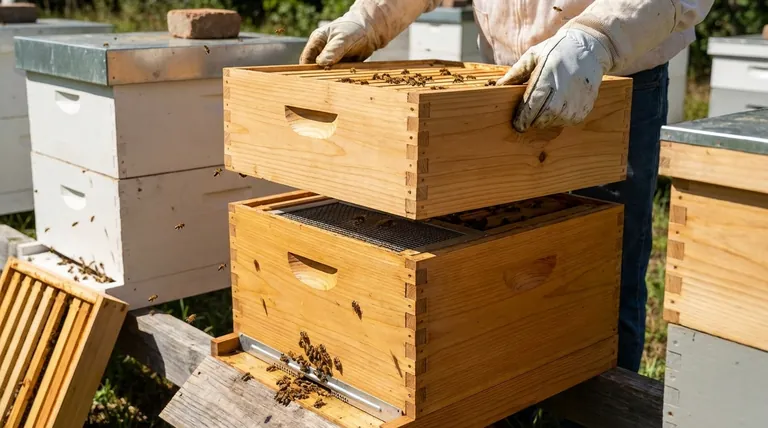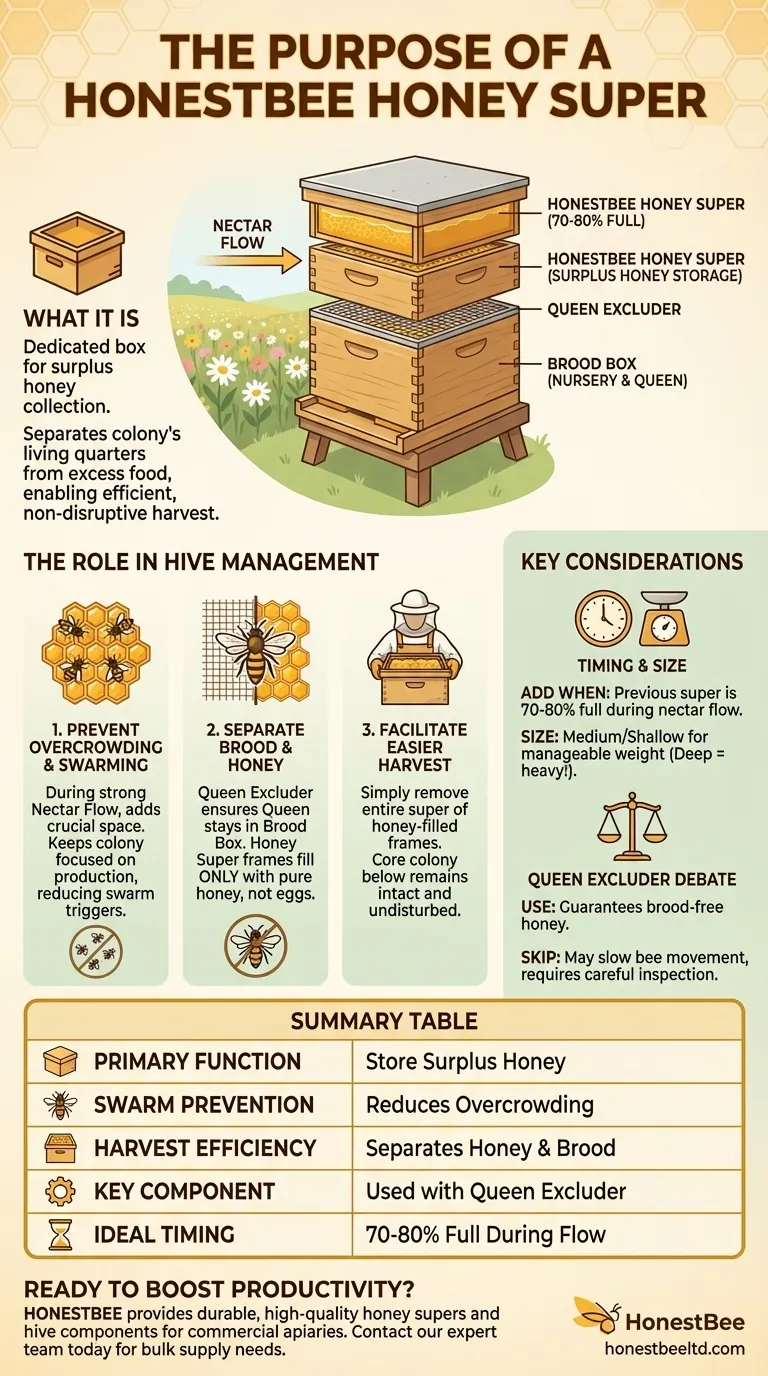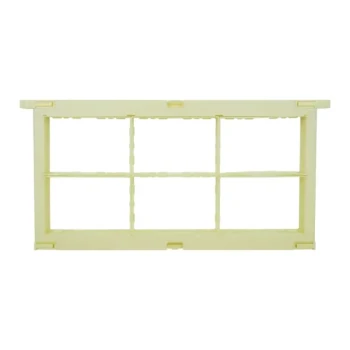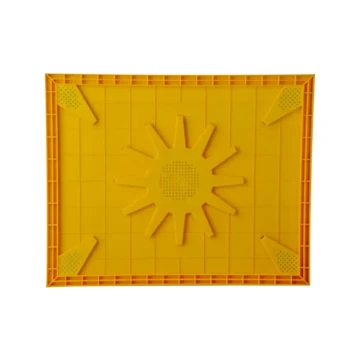In essence, a honey super is a dedicated box placed on a beehive for the sole purpose of collecting surplus honey. It provides the honeybees with additional space to store honey beyond what they need for their own survival, creating a designated area for the beekeeper to harvest from without disturbing the core of the colony.
The honey super is a strategic management tool that cleanly separates the colony's living quarters from their excess food storage. This separation makes honey harvesting efficient for the beekeeper and far less disruptive for the bees.

The Role of a Super in Hive Management
A honey super isn't just an extra box; it's a critical component for managing a healthy and productive hive. Its use is timed to coincide with the natural rhythms of the colony and its environment.
Preventing Overcrowding and Swarming
During a strong nectar flow—the period when flowers are producing abundant nectar—a colony can bring in resources very quickly.
Without extra space, the bees will fill every available cell with nectar, leaving the queen with nowhere to lay eggs. This sense of being "honey bound" or overcrowded is a primary trigger for the colony to swarm, where the old queen leaves with half the bees to find a new home.
Adding a super provides this crucial extra space, giving the worker bees a project and keeping the colony focused on production rather than reproduction.
Separating Brood from Honey
The lower boxes of a hive, known as brood boxes, are where the queen lays her eggs and the colony raises its young (the brood). This is the nursery and core of the hive.
Honey supers are placed on top of these brood boxes. Critically, beekeepers often place a queen excluder between the brood box and the supers. This is a screen with gaps large enough for worker bees to pass through but too small for the larger queen.
This ensures the queen stays in the brood boxes to lay eggs, meaning the frames in the honey super will be filled only with honey, not with eggs or larvae.
Facilitating an Easier Harvest
By keeping the brood and honey separate, the honey super makes harvesting a straightforward process.
The beekeeper can remove the entire super, confident that it contains only honey-filled frames. This allows the core of the colony in the brood boxes below to remain intact and undisturbed, ensuring its continued health and stability.
Key Considerations for Using a Honey Super
While the concept is simple, the effective use of a honey super requires proper timing and an understanding of the trade-offs involved.
When to Add a Super
Timing is everything. If you add a super too early in the season, the bees will have a large, empty space to heat and defend, which can stress the colony.
If you add it too late, you may have already missed the peak nectar flow or inadvertently encouraged the hive to swarm. The ideal time is when the last super you added is about 70-80% full of bees and nectar.
The Queen Excluder Debate
While queen excluders are standard practice for ensuring brood-free honey, they are a topic of debate.
Some beekeepers argue that the excluder can slow down worker bees as they move into the supers, slightly reducing the speed of honey production. Forgoing an excluder requires more careful inspection during harvest but is a valid management choice.
Choosing the Right Size
Honey supers are typically medium or shallow boxes, rather than the larger "deep" boxes used for brood.
The reason is simple: weight. A deep box full of honey can weigh over 80 pounds (36 kg), making it extremely difficult to lift. Shallower supers are far more manageable for the beekeeper.
Making the Right Choice for Your Goal
Your approach to using a honey super depends on your primary beekeeping objective.
- If your primary focus is maximizing a clean honey harvest: Use a queen excluder to guarantee pure honey frames and add supers proactively just before the main nectar flow begins.
- If your primary focus is ease of physical handling: Always opt for shallow or medium supers, as a deep super full of honey can be exceptionally heavy and difficult to lift safely.
- If your primary focus is minimal hive intervention: You might choose to operate without a queen excluder, but be prepared for the possibility of finding brood in your honey frames, which requires more careful management.
Ultimately, mastering the use of the honey super is fundamental to transitioning from simply keeping bees to successfully and sustainably harvesting honey.
Summary Table:
| Aspect | Purpose & Benefit |
|---|---|
| Primary Function | Provides dedicated space for bees to store surplus honey. |
| Swarm Prevention | Reduces overcrowding, a key trigger for swarming. |
| Harvest Efficiency | Separates honey from brood, allowing for easy, non-disruptive harvests. |
| Key Component | Used with a queen excluder to keep the brood chamber pure. |
| Ideal Timing | Added when the existing super is 70-80% full during a nectar flow. |
Ready to boost your apiary's productivity with the right equipment?
As a trusted wholesale supplier for commercial apiaries and beekeeping equipment distributors, HONESTBEE provides the durable, high-quality honey supers and hive components you need to manage your colonies efficiently and maximize your honey yield.
Contact our expert team today to discuss your bulk supply needs and discover how our products support sustainable, profitable beekeeping operations.
Visual Guide

Related Products
- Langstroth Honey Bee Box Hive Boxes for Different Depths
- Professional 500g Sectional Comb Honey Frame System for Beekeeping
- Automatic Heat Preservation 6 Frame Pro Nuc Box for Honey Bee Queen Mating
- Twin Queen Styrofoam Honey Bee Nucs Mating and Breeding Box
- Australian Langstroth Beehive Boxes for Beekeeping Wholesales
People Also Ask
- How is checking honey supers in a Langstroth hive different from inspecting Honey Flow supers? A Guide to Disruptive vs. Non-Invasive Methods
- How deep is a medium bee box? Unlock the Key to a Versatile and Manageable Hive
- What is the best time to inspect a hive? Optimize for Bee and Beekeeper Safety
- How does a hive box work? A Guide to the Langstroth Hive System for Beekeepers
- What is the purpose of the boxes in a Langstroth hive? A Guide to Modular Beekeeping Success



















